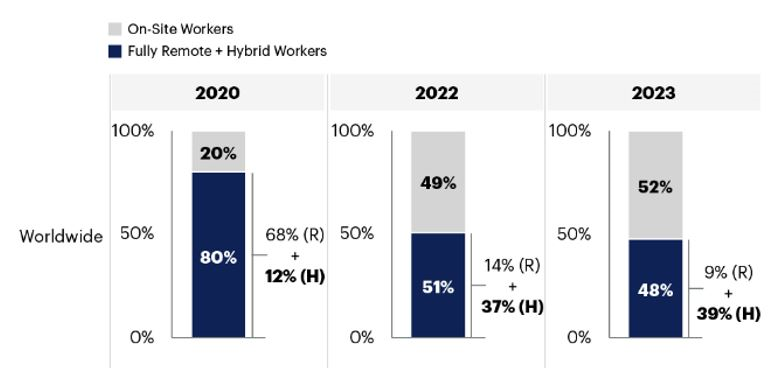- Only 9% of Global Knowledge Workers Will Work Fully Remote.
- Human-Centric Design Can Help Alleviate IT Talent Crunch
By the end of 2023, 39% of global knowledge workers will work hybrid, up from 37% in 2022, according to Gartner, Inc.
“Hybrid is no longer just an employee perk but an employee expectation,” said Ranjit Atwal, Senior Director Analyst at Gartner. “Many employees started to partially return to the office in 2022, but the hybrid workstyle will remain prominent in 2023 and beyond. To adapt, employers have been implementing a human-centric work design – including flexibility, intentional collaboration and empathy-based management – which suits hybrid employees.”
For example, IT workers are more inclined to quit their jobs than employees in other functions as they look for greater flexibility, improved work-life balance and better career opportunities. CIOs can maximize retention and attraction of talent by resetting their employee value proposition with a more human deal.
Gartner defines hybrid workers as workers who work in the office at least one day a week. Fully remote workers are those working from home all the time. On-site workers are those who work on-site full time, not working at home at any time.
The number of remote workers is expected to continue to fall year over year. Gartner estimates that remote workers will represent only 9% of all employees worldwide by the end of 2023 (see Figure 1).
Figure 1: Knowledge Workers’ Share for Fully Remote and Hybrid, Worldwide, 2020, 2022 and 2023
Source: Gartner (March 2023)
While all countries have increased their proportion of hybrid and fully remote work since 2019, the allure of fully remote and hybrid work varies significantly by country.
Human-Centric Design Meets the Virtual Workspace
Human-centric design requires a new set of principles, norms and thinking. Successful virtual workspaces will increase the ability to hire and bring together employees regardless of geographic location. Virtual workspaces provide potentially disruptive new alternatives to in-person meetings (and the associated travel) and to existing, virtual meeting solutions. Gartner predicts that by 2025, 10% of workers will use virtual spaces for activities such as sales, onboarding and working remotely.
“For remote-first or hybrid organizations, fully mature virtual workspaces may replace the office as the embodiment of company culture and become the center of the digital employee experience,” said Christopher Trueman, Senior Principal Analyst at Gartner. “However, employees should not be expected to engage in the virtual workspace for their entire workday. Virtual workspaces should only be used for meetings and interactions that will be enhanced by them, such as brainstorming, product reviews, or social gatherings.”
Gartner clients can read more in “Forecast Analysis: Knowledge Employees, Hybrid, Fully Remote and On-Site Work Styles, Worldwide.”
About Gartner for Information Technology Executives
Gartner for Information Technology Executives provides actionable, objective insight to CIOs and IT leaders to help them drive their organizations through digital transformation and lead business growth. Additional information is available at www.gartner.com/en/information-technology.
Follow news and updates from Gartner for IT Executives on Twitter and LinkedIn. Visit the IT Newsroom for more information and insights.
About Gartner
Gartner, Inc. (NYSE: IT) delivers actionable, objective insight to executives and their teams. Our expert guidance and tools enable faster, smarter decisions and stronger performance on an organization’s mission critical priorities. To learn more, visit gartner.com.
Source: PC and Associates Consulting

